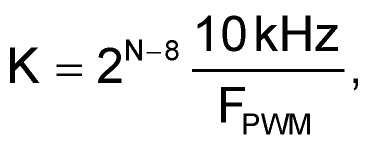This design idea (DI) takes an unusual path to a power-handling DAC by merging an upside-down LM337 regulator with a simple (just one generic chip) PWM circuit to make a 20-V, 1-A current source. It’s suitable for magnet driving, battery charging, and other applications that might benefit from an agile and inexpensive computer-controlled current source. It profits from the accurate internal voltage reference, overload, and thermal protection features of that time proven and famous Bob Pease masterpiece!
Full throttle (PWM duty factor = 1) current output accuracy is entirely determined by R4’s precision and the ±2% (guaranteed, typically lots better) accuracy of the LM337 internal reference. It’s thus independent of the (sometimes dodgy) precision of logic supplies as basic PWM DACs often are not.
Figure 1 shows the circuit.
 |
|
| Figure 1. | LM337 mates with a generic hex inverter to make an inexpensive 1-A PWM current source. (* = 1% metal film). IOUT = 1.07(D – 0.07), IOUT > 0. |
ACMOS inverters U1b through U1f accept a 10 kHz PWM signal to generate a –50 mV to +1.32 V “ADJ” control signal for the U2 current regulator proportional to the PWM duty factor (D). Of course, other PWM frequencies and resolutions can be accommodated with the suitable scaling of C1 and C2. See the “K” factor arithmetic below.
D = 0 drives ADJ > 1.25 V and causes U2 to output the 337’s minimum current (about 5 mA) as shown in Figure 1’s caption.
IOUT = 1.07(D – 0.07).
The 7% zero offset was put in to insure that D = 0 will solidly shut off U2 despite any possible mismatch between its internal reference and the +5 V rail. It’s always struck me as strange that a negative regulator like the 337 sometimes needs a positive control signal, but in this case it does.
U1a generates an inverse of the PWM signal, providing active ripple cancellation as described in “Cancel PWM DAC ripple with analog subtraction” (Ref. 1). Since ripple filter C1 and C2 capacitors are shown sized for 8 bits and a 10-kHz PWM frequency, for this scheme to work properly with different frequency and resolution, the capacitances will need to be multiplied by a factor K:

N = bits of PWM resolution,
FPWM = PWM frequency.
If more current capability is wanted, the LM337 is rated at 1.5 A. That can be had by simply substituting a heavier-duty power adapter and making R4 = 0.87 ohms. Getting even higher than that limit, however, would require paralleling multiple 337s, each with its own R4 to ensure equal load sharing.
Finally, a word about heat. U2 should be adequately heatsunk as dictated by heat dissipation equal to output current multiplied by the (24 V – VOUT) differential. Up to double-digit wattage is possible, so don’t skimp in the heatsink area. The 337s go into automatic thermal shutdown at junction temperatures above 150 °C so U2 will never cook itself. But make sure it will pass the wet-forefinger-sizzle “spit test” anyway so it won’t shut off sometime when you least expect (or want) it to!
References
- Woodward, Stephen. "Cancel PWM DAC ripple with analog subtraction. "